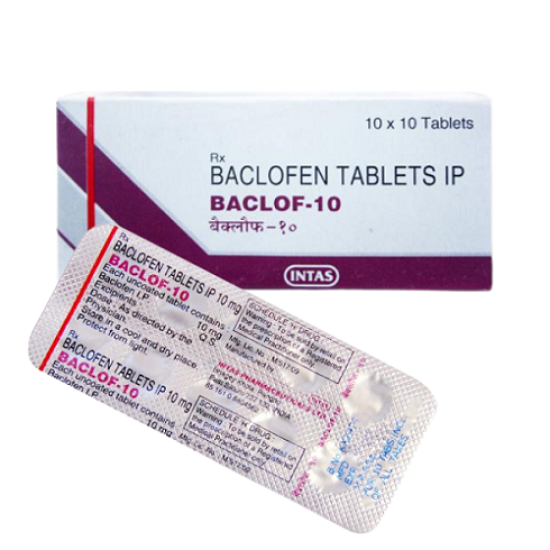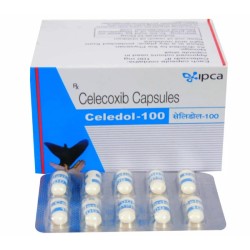Buy Baclof 10 mg Online | Fast Relief for Muscle Spasms

- Stock: In Stock
- Brand: Intas Pharmaceuticals Ltd
- Model: Baclof 10mg
- SKU: BCLF10
- Active Ingredient: Baclofen
- Treatment: Muscle Pain
- Alcohol: Don't Drink
- MPN: B57L74F98
Available Options
Introduction to Baclof 10 mg
Baclof 10 mg
is a muscle relaxant primarily used to treat muscle spasms and stiffness
associated with conditions such as multiple sclerosis and spinal cord injuries.
By acting on the central nervous system, it helps to alleviate discomfort and
improve mobility.
Baclofen is
typically administered in tablet form and is important to take as prescribed by
a healthcare provider to minimize side effects, which may include drowsiness
and dizziness. Proper management and communication with a healthcare
professional are essential for effective treatment.
How Baclofen 10 mg Functions in the Body
Baclof 10 mg
works by acting on the central nervous system, specifically targeting the GABA
(gamma-aminobutyric acid) receptors in the spinal cord. GABA is a
neurotransmitter that inhibits nerve activity, leading to a reduction in muscle
tone and relaxation of spastic muscles. By enhancing the effects of GABA,
Baclofen decreases the frequency and intensity of muscle spasms and stiffness.
This
mechanism helps alleviate discomfort and improve mobility in individuals
suffering from conditions such as multiple sclerosis and spinal cord injuries.
Additionally, Baclof may also reduce the perception of pain associated with
muscle spasms, contributing to overall relief and improved quality of life.
Indications: When is Baclof 10 mg Prescribed?
Baclof 10 mg
is prescribed for several specific indications, primarily related to conditions
that cause muscle spasms and spasticity. Common indications include:
Multiple
Sclerosis: Baclof is often used to manage muscle stiffness and spasms
associated with multiple sclerosis, helping to improve mobility and reduce
discomfort.
Spinal Cord
Injuries: Patients with spinal cord injuries may experience muscle spasms and
spasticity, and Baclof can help alleviate these symptoms.
Cerebral
Palsy: Baclof may be prescribed to manage spasticity in individuals with
cerebral palsy, improving muscle control and function.
Other
Neurological Disorders: It can also be used for various other neurological
conditions that result in muscle spasticity, providing symptomatic relief.
Muscle
Spasms: Baclof may be prescribed for acute muscle spasms resulting from injury
or overuse, helping to relax the affected muscles.
Overall,
Baclof is indicated for conditions characterized by increased muscle tone and
spasms, aiming to enhance the patient's quality of life and functional
abilities.
Dosage and Administration of Baclof 10 mg
The dosage and administration of Baclof 10 mg should always be guided by a healthcare professional, and tailored to the individual patient's needs. Generally, the following guidelines apply:
Initial
Dose: Treatment usually begins with a low dose, often starting at 5 mg taken
three times a day. This allows the body to adjust to the medication and helps
minimize side effects.
Titration: The
dosage can be slowly adjusted depending on how the patient responds and their
level of tolerance. Increments of 5 mg can be made every few days, with a
typical maximum daily dose reaching up to 80 mg, divided into multiple doses.
Maintenance
Dose: The effective maintenance dose varies among individuals, but it often
falls between 20 mg to 80 mg per day, divided into several doses.
Administration:
Baclof 10 mg is usually taken orally, with or without food. It’s important to
swallow the tablets whole with water and not to crush or chew them.
Discontinuation:
If discontinuing Baclof, it is crucial to taper the dosage gradually under
medical supervision to avoid withdrawal symptoms.
Patients
should always follow their healthcare provider’s specific instructions
regarding dosage and administration, and report any adverse effects or concerns
during treatment.
Potential Side Effects of Baclof 10 mg
Baclof 10
mg, like any medication, can cause side effects. While not everyone experiences
them, it's crucial to recognize the possible negative effects. Common side
effects include:
- Drowsiness
or Sedation
- Dizziness or
Lightheadedness
- Weakness or
Fatigue
- Nausea or
Vomiting
- Constipation
- Headache
Precautions and Contraindications
When
prescribing Baclof 10 mg, several precautions and contraindications should be
considered to ensure patient safety and effective treatment. Here are the key
points:
Precautions:
CNS
Depression: Baclof can cause drowsiness and sedation. Caution should be
exercised when operating machinery or driving until the individual knows how
the medication affects them.
Alcohol and
CNS Depressants: The use of Baclof with alcohol or other central nervous system
depressants (e.g., benzodiazepines, opioids) can enhance sedative effects and
increase the risk of respiratory depression.
Elderly
Patients: Older adults may be more sensitive to the effects of Baclof,
particularly regarding sedation and dizziness. Dose adjustments may be
necessary.
History of
Substance Abuse: Patients with a history of substance abuse should be monitored
closely, as Baclof can be misused.
Seizure
Disorders: Baclof should be used cautiously in patients with a history of
seizures, as abrupt withdrawal can precipitate seizures.
Renal
Impairment: Patients with renal impairment may require dose adjustments, as
Baclofen is primarily excreted by the kidneys.
Hepatic
Impairment: Caution is advised in patients with liver disease, as metabolism
may be affected.
Pregnancy
and Lactation: The safety of Baclof during pregnancy and breastfeeding has not
been fully established. It should only be used if the potential benefits are
greater than the risks involved.
Contraindications:
Hypersensitivity:
Baclof is contraindicated in individuals with a known hypersensitivity to baclofen
or any of its components.
Severe Renal
Impairment: Baclof is contraindicated in patients with severe renal impairment
due to the risk of accumulation and toxicity.
Active
Peptic Ulcer Disease: Baclof can increase the risk of gastrointestinal bleeding
and should be avoided in patients with active peptic ulcers.
Intrathecal
Baclofen Therapy: Baclof should not be used in patients who are receiving
intrathecal baclofen therapy.
Comatose
Patients: Baclof should not be administered to patients who are unconscious or in
a reduced level of consciousness.
Drug Interactions with Baclof 10 mg
Baclof 10 mg
can interact with several medications and substances, which may enhance side
effects or alter the effectiveness of either drug. Here are some important drug
interactions to be aware of:
1. CNS Depressants
Alcohol:
Concurrent use can increase sedation and respiratory depression.
Benzodiazepines:
Increased risk of sedation and respiratory depression.
Opioids:
Enhanced sedative effects and potential for respiratory depression.
Antidepressants:
Certain antidepressants, especially those with sedative properties, may
increase the risk of drowsiness.
2. Antihypertensive Medications
Baclofen can
lower blood pressure, and when taken with antihypertensive drugs, there may be
an additive effect leading to hypotension.
3. Diuretics
Baclofen may
increase the risk of dehydration or electrolyte imbalances when used with
diuretics.
4. Anticonvulsants
Patients
taking anticonvulsants should be monitored closely, as Baclof can lower the
seizure threshold, particularly if it is abruptly discontinued.
5. Muscle Relaxants
The sedative
effects may be enhanced when used with other muscle relaxants.
6. Other Medications
Monoamine Oxidase
Inhibitors (MAOIs): Use with caution, as the combination can lead to increased
side effects.
Tricyclic
Antidepressants (TCAs): May increase the risk of sedation and other side
effects.
7. Pharmacokinetic Interactions
Baclofen is
primarily excreted by the kidneys, so medications that affect renal function
may alter its clearance and increase the risk of toxicity.
Baclof 10 mg for Long-Term Use
Long-term
use of Baclof 10 mg can lead to several considerations regarding its effects
and potential withdrawal symptoms. While Baclofen is generally well-tolerated,
prolonged use may result in some side effects and complications.
Long-Term Use Effects
Tolerance:
Over time, patients may develop tolerance, requiring higher doses to achieve
the same therapeutic effects.
Dependence:
Prolonged use can lead to physical dependence, where the body adapts to the
presence of the drug, making it difficult to function normally without it.
Psychological
Effects: Users may experience mood changes, anxiety, or depression,
particularly if they have been using Baclofen for an extended period.
Rebound Symptoms: If Baclof is discontinued suddenly, patients may experience a return of the symptoms it was initially prescribed to treat, such as muscle rigidity and spasticity.
FAQs:
1. Can Baclof 10 mg be used for conditions other than muscle spasms?
- While Baclof is primarily prescribed for muscle spasms and spasticity, some healthcare providers may use it off-label for conditions like chronic pain syndromes, anxiety disorders, or even as part of a treatment plan for alcohol withdrawal. It's important to seek guidance from your healthcare provider for tailored advice.
2. How long does it take for Baclof 10 mg to start working?
- Patients may begin to notice relief from muscle spasms within a few hours of taking Baclof, but it can take several days to weeks for the full therapeutic effects to be realized. Individual responses can vary based on the condition being treated and the dosage.
3. What should I do if I miss a dose of Baclof?
- If you forget to take a dose of Baclof, take it as soon as you remember. However, if it’s nearly time for your next dose, just skip the missed dose and continue with your regular schedule. Avoid taking two doses at the same time to make up for a missed one.
4. If I experience severe side effects, what steps should I take?
- If you experience severe side effects such as difficulty breathing, severe dizziness, or an allergic reaction (rash, itching, swelling), seek immediate medical attention. It’s crucial to report any serious side effects to your healthcare provider as well.














![Celexa Generic 40 Mg [Citalopram Brand Name], Uses, Reviews & Price Celexa Generic 40 Mg [Citalopram Brand Name], Uses, Reviews & Price](https://buymedlife.com/image/cache/catalog/Pain%20relief/Citara%2040mg-250x250w.png)


